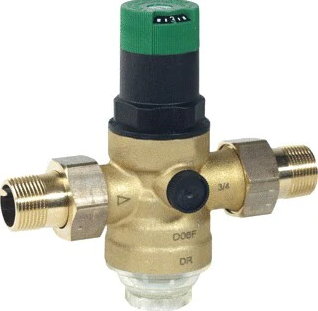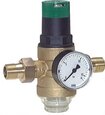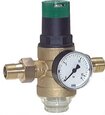Selecting a Water Pressure Regulator For a Home

Figure 1: A brass water pressure regulator with a port connection for a pressure gauge.
Selecting the right home water pressure regulator is a crucial decision that impacts the plumbing system's longevity and its residents' comfort. A water line pressure regulator, also known as a pressure-reducing valve, automatically reduces the water pressure from the main water line to a safe and manageable level for a home's plumbing. High water pressure can lead to pipe damage, leaky appliances, and wasted water, while low pressure can affect the efficiency of showers, faucets, and irrigation systems. Therefore, understanding a water pressure regulator's specifications, sizing, and installation requirements is essential for maintaining an optimal balance in the household's water supply. The article guides homeowners through assessing their water pressure needs and selecting a regulator that ensures durability and consistent performance.
View our online selection of water pressure regulators!
Understanding water pressure needs
Water pressure is measured in bars or pounds per square inch (psi), and residential water systems typically require a pressure range between 2.7 - 4.1 bar (40 - 60 psi) to function effectively. Here are steps to assess a home's water pressure needs:
- Gauge the incoming water pressure:
- Purchase a water pressure gauge from a home improvement store.
- Attach the gauge to an outdoor hose faucet or washing machine faucet.
- Turn on the faucet to its maximum and record the pressure reading.
- Perform this test at different times to account for fluctuations during peak usage hours.
- Evaluate fixture and appliance requirements:
- Check the manufacturer's specifications for pressure recommendations for dishwashers, washing machines, and water heaters.
- Ensure that the water pressure is within the range suggested by manufacturers to prevent damage and ensure warranty compliance.
- Consider usage patterns:
- Reflect on times when water demand is highest, such as morning routines or laundry days, and note any issues with water pressure consistency.
- Account for the number of bathrooms and occupants, as high-occupancy homes may require a more robust pressure management system.
- Assess the effects of high pressure:
- Look for signs of excessive water pressure, such as loud pipes, dripping faucets, leaks, or short cycles on the water pump.
- High pressure can lead to faster wear and tear on plumbing components, increasing maintenance costs.
Determining the need for a pressure regulator
A house water pressure regulator may be necessary if the water pressure exceeds 4.1 bar (60 psi), especially during low-usage hours. This device, installed where the main water line enters the home, reduces the pressure from the municipal supply to a safe level.
Choosing the right water pressure regulator
There are three types of water pressure regulators suitable for typical residential plumbing systems:
- Spring-loaded regulators
- Diaphragm regulators
- Two-stage regulators
Spring-loaded regulators
Spring-loaded regulators are the most common type found in residential settings. They use a spring that applies pressure to a diaphragm, controlling the water flow. They are compact, cost-effective, and simple to install. They are ideal for small homes and areas with relatively stable incoming water pressure. Homeowners may choose a spring-loaded regulator when they need a straightforward, low-maintenance solution for moderate-pressure water sources.
Diaphragm regulators
Diaphragm regulators, similar to spring-loaded regulators, use a diaphragm but typically offer more precision and stability. They are often selected for their durability and the fine control they provide over water pressure adjustments. These regulators are particularly effective in situations with fluctuating upstream pressure or where precise pressure control is necessary to protect sensitive plumbing fixtures.
Two-stage regulators
Two-stage regulators consist of two single regulators in series that work together to maintain a consistent pressure level. The first stage reduces the incoming pressure to an intermediate level, and the second stage further reduces it to the desired level. They are used in homes with very high or highly variable incoming water pressure because they provide a more stable output pressure. Two-stage regulators are the choice for homeowners dealing with significant pressure fluctuations and willing to invest in a more robust system for optimal pressure control.
Selection guide
When installing a new regulator or replacing one, consider the following factors:
- Size and compatibility: Choose a regulator that matches the diameter of the home's incoming water supply line, typically ranging from 12.7 - 25.4 mm (1/2 to 1 inch).
- Material: Opt for brass regulators, which offer durability and corrosion resistance. Stainless steel water pressure regulators are available but are not cost-effective for residential plumbing systems.
- Adjustment range: Select a regulator with an adjustment range that includes the home's optimal pressure range. Learn more in our water pressure regulator adjustment article.
-
Quality and certification: Look for regulators that meet industry standards and certifications, ensuring reliability and safety.
- ASSE 1003: This standard applies to water pressure reducing valves for domestic water supply systems.
- NSF/ANSI 61: This standard ensures that the materials and products do not contribute harmful contaminants to drinking water.
- NSF/ANSI 372: This standard ensures that products meet the lead content requirements for "lead-free" plumbing as defined by the U.S. Safe Drinking Water Act.
- ISO 9001: This is a quality management standard that manufacturers may adhere to for the design, production, and distribution of their products, including water pressure regulators.
- Additional features: Some regulators come with built-in gauges or are preset to a specific pressure, adding convenience to installation and monitoring.
Learn more in our water pressure regulator overview article.
FAQs
What should a water pressure regulator be set at in a house?
A home's water pressure regulator should be set between 2.7 and 4.1 bar (40 - 60 psi).
Should a house have a water pressure regulator?
Whether or not a house needs a water pressure regulator depends on local regulations. For example, some regulations require a regulator if the water coming in the mains is 4.8 bar (70 psi) or higher.








